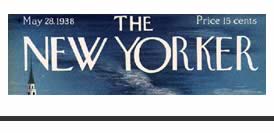The Achievement of The New Yorker
"The new magazine reflected the reckless detachment of the period.
It wore no armor and it sought no grail; it did not carry a swordcane
or even an umbrella. Since neither trumpet nor umbrella had called it
into existence, it was not going anywhere to do anything about anything.
It was just walking along, like any other visitor from out of town, looking
into the expensive store windows, gazing up at the tall buildings, widening
its eyes and dropping its jaw at impressive statistics or unusual facts."
Thurber, This Petty Pace, beneath, intro. "...in 1925, the seeds
of a new style of pictorial humour were sown, that was to grow up and
spread until it covered every corner of the field. I have couples the
radio and the movies together as the cause of the revolution, but in fact
of course the chief impact came from the radio, since this was or could
be busy impacting all day and well into the night.... the very influence
of the outlines of an animated cartoon stimulated the pictorial humourist
to try to introduce more movement into his drawings, and also more dynamic
line formulae.....development was very much helped by the happy fact that
a new humourous paper started just at the right moment and under the right
editor.... As a new production this had no ready made traditions that
needed careful handling, nor was there any deadweight of old subscribers
unfamiliar with the new developments and fiercely resentful of change....
[generally] legends became simpler and simpler. And in order to fall into
line with movie and radio, where so much depends on quickness and suddeness,
draughtsmanship began to concentrate on suddeness of impact and quickness
of execution...." Fougasse (Kenneth Bird), The Good Tempered
Pencil Reinhardt London 1956.
"While British artists largely employed themselves exploring avenues,
producing a wide range and variety of styles, American artists were more
concerned with perfecting the relationship between subject and treatment."
Fougasse as above p.111.
The New Yorker ,founded February 1925, Eustace Tilley the monocled Regency
Dandy (Rea Irvin). In 1927 begins to pay its way.
managing
editor,Harold Ross (d1951) with Andy White and James Thurber
art editors Rea Irvin, James Geraghety, Lee Lorenz;
the Tuesday art meetings, filtering processes, Ross and Capote.
Visual components,
the
cover , Petruccelli, Bemelmans, Ilonka Karasz, Alajalov, Ed
Koren, Mary Petty, Andre Francois, Steinberg
decorative vignettes , Rea Irvin, Richard Edes Harrison.
ideas
drawings , Gluyas Williams, Gardner Rea, Mary Petty, James
Thurber Ralph Barton, Clarence Day, Wallace Morgan. Charles Addams,
William Steig, Peter Arno.
The line drawing and the wash drawing .
Compare
with Thurber with Clarence Day and comment on the use of the caption.
Influences
H.M.Bateman,
the Tatler drawings
Max Beerbohm, and the concept of the dandy.
Caran d'Ache the pioneer of the comic strip.
Writers
John O'Hara, John Updike, John Cheever, Rebecca West, John Hersey.
Components
fiction, non-fiction (Reporter at Large), and criticism.
Desk staff Wolcott Gibbs, Edmund Wilson, Robert Benchley, William Shawn,
continuity of staff and chaos theory of management.
Prospectus
1924
"There will be a personal mention column - a jotting down in the
small town newspaper style of the comings, goings and doings in the village
of New York. This will contain some josh and and some news value."
J.Thurber below p. 20. "Compared to the enwspaper, it interprets
rather than chronicles. It gives the colour, the tang, the anecdote, and
the chat in all the sophisticated circles in New York. It is a magazine
avowedly for a metroploitan audience. " original New Yorker advertisement.
Statistics
INCOME in 1929, before the Great Financial Crash,
cover price 15cents.
Revenue gross advertising earnings* 1,929,,964
newstand income 191,149
subscription revenue 139,985
all other income 23,686
TOTAL 2,290,784
EXPENDITURE
paper
228,786
printing 248,728
engraving 33,576
postage 28,368
mailing 7,930
editorial departments # 310,652<
advertising selling 315,258
advertising agency commissions 289,494
circulation departments 94,207
admin. and unapportioned expenditure 215,758
TOTAL 1,773,027
net profit 517,757
circulation;
1929 80,000, 1934 125,000
out of 125,000 62,000 READERS live within 50 miles of NY centre.
14% of budget, and $442,000 in 1934. Average editorial costs for
a comprative American magazine, $200,000 to 300,000
Average costs for a single copy; all in dollars
Art
1,800
Manuscripts
1,800
Regular
contributors (departments) 1,800
Salaries
2,200
Miscellaneous
400
total
8,000
Art
costs
decorative spot 20 idea drawings 50-100
full page drawings 125 - 200 covers 200
|















